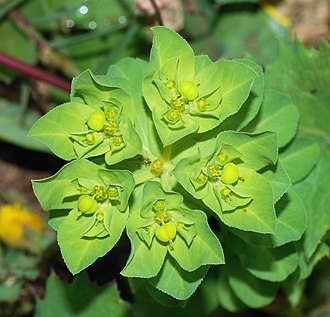Euphorbia

Euphorbia is a very large and diverse genus of flowering plants, commonly called spurge, in the spurge family (Euphorbiaceae). “Euphorbia” is sometimes used in ordinary English to collectively refer to all members of Euphorbiaceae (in deference to the type genus), not just to members of the genus.[2] Some euphorbias are commercially widely available, such as poinsettias at Christmas. Some are commonly cultivated as ornamentals, or collected and highly valued for the aesthetic appearance of their unique floral structures, such as the crown of thorns plant (Euphorbia milii). Euphorbias from the deserts of Southern Africa and Madagascar have evolved physical characteristics and forms similar to cacti of North and South America, so they (along with various other kinds of plants) are often incorrectly referred to as cacti.[3] Some are used as ornamentals in landscaping, because of beautiful or striking overall forms, and drought and heat tolerance.[4][5]
Euphorbias range from tiny annual plants to large and long-lived trees.[5] The genus has over[4] or about 2,000 members,[6] making it one of the largest genera of flowering plants.[7][8] It also has one of the largest ranges of chromosome counts, along with Rumex and Senecio.[7] Euphorbia antiquorum is the type species for the genus Euphorbia.[9] It was first described by Carl Linnaeus in 1753 in Species Plantarum.
The plants share the feature of having a poisonous, milky, white, latex-like sap, and unusual and unique floral structures.[4] The genus may be described by properties of its members’ gene sequences, or by the shape and form (morphology) of its heads of flowers. When viewed as a whole, the head of flowers looks like a single flower (a pseudanthium).[4] It has a unique kind of pseudanthium, called a cyathium, where each flower in the head is reduced to its barest essential part needed for sexual reproduction.[4] The individual flowers are either male or female, with the male flowers reduced to only the stamen, and the females to the pistil.[4] These flowers have no sepals, petals, or other parts that are typical of flowers in other kinds of plants.[4] Structures supporting the flower head and other structures underneath have evolved to attract pollinators with nectar, and with shapes and colors that function in a way petals and other flower parts do in other flowers. It is the only genus of plants that has all three kinds of photosynthesis, CAM, C3 and C4.[4]
Among laypeople, Euphorbia species are among the plant taxa most commonly confused with cacti, especially the stem succulents.[10] Euphorbias secrete a sticky, milky-white fluid with latex, but cacti do not.[10] Individual flowers of euphorbias are usually tiny and nondescript (although structures around the individual flowers may not be), without petals and sepals, unlike cacti, which often have fantastically showy flowers.[10] Euphorbias from desert habitats with growth forms similar to cacti have thorns, which are different from the spines of cacti.[10]
The common name “spurge” derives from the Middle English/Old French espurge (“to purge”), due to the use of the plant’s sap as a purgative. The botanical name Euphorbia derives from Euphorbos, the Greek physician of King Juba II of Numidia (52–50 BC – 23 AD), who married the daughter of Anthony and Cleopatra.[11] Juba was a prolific writer on various subjects, including natural history. Euphorbos wrote that one of the cactus-like euphorbias (now called Euphorbia obtusifolia ssp. regis-jubae) was used as a powerful laxative.[11] In 12 BC, Juba named this plant after his physician Euphorbos, as Augustus Caesar had dedicated a statue to the brother of Euphorbos, Antonius Musa, who was the personal physician of Augustus.[11] In 1753, botanist and taxonomist Carl Linnaeus assigned the name Euphorbia to the entire genus in the physician’s honor.[12]
